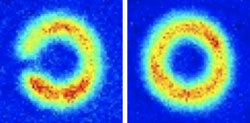The first non-trivial atom circuit: Progress toward an atom SQUID

Atom circuit: False color images of an "atom circuit" made of an ultracold sodium gas. Red denotes a greater density of atoms and traces the path of circulating atoms around the ring. A laser-based barrier can stop the flow of atoms around the circuit (left); without the barrier the atoms circulate around the ring (right). Credit: JQI/NIST<br>
The circuit is “nontrivial” because it includes a circuit element—an adjustable barrier that controls the flow of atom current to specific allowed values. The newly published* work was done at the Joint Quantum Institute, a NIST/UM collaboration.
Ultracold gases, such as the Bose-Einstein condensate of sodium atoms in this experiment, are fluids that exhibit the unusual rules of the quantum world. Atomic quantum fluids show promise for constructing ultraprecise versions of sensors and other devices such as gyroscopes (which stabilize objects and aid in navigation). Super?uid helium circuits have already been used to detect rotation. Superconducting quantum interference devices (SQUIDs) use superconducting electrons in a loop to make highly sensitive measurements of magnetic fields. Researchers are striving to create an ultracold-gas version of a SQUID, which could detect rotation. Combined with ultracold atomic-gas analogs of other electronic devices and circuits, or “atomtronics” that have been envisioned, such as diodes and transistors, this work could set the stage for a new generation of ultracold-gas-based precision sensors.
To make their atom circuit, researchers created a long-lived persistent current—a frictionless flow of particles—in a Bose-Einstein condensate of sodium atoms held by an arrangement of lasers in a so-called optical trap that confines them to a toroidal, or donut, shape. Persistent flow—occurring for a record-high 40 seconds in this experiment—is a hallmark of superfluidity, the fluid analog of superconductivity.
The atom current does not circle the ring at just any velocity, but only at specified values, corresponding in this experiment to just a single quantum of angular momentum. A focused laser beam creates the circuit element—a barrier across one side of the ring. The barrier constitutes a tunable “weak link” that can turn off the current around the loop.
Superflow stops abruptly when the strength of the barrier is sufficiently high. Like water in a pinched garden hose, the atoms speed up in the vicinity of the barrier. But when the velocity reaches a critical value, the atoms encounter resistance to flow (viscosity) and the circulation stops, as there are no external forces to sustain it.
In atomic Bose-Einstein condensates, researchers have previously created Josephson junctions, a thin barrier separating two superfluid regions, in a single atomic trap. SQUIDs require a Josephson junction in a circuit. This present work represents the implementation of a complete atom circuit, containing a superfluid ring of current and a tunable weak link barrier. This is an important step toward realizing an atomic SQUID analog.
* A. Ramanathan, K. C. Wright, S. R. Muniz, M. Zelan, W. T. Hill III, C. J. Lobb, K. Helmerson, W. D. Phillips and G. K. Campbell. Super?ow in a toroidal Bose-Einstein condensate: an atom circuit with a tunable weak link. Physical Review Letters. Published online March 28, 2011.
Media Contact
More Information:
http://www.nist.govAll latest news from the category: Physics and Astronomy
This area deals with the fundamental laws and building blocks of nature and how they interact, the properties and the behavior of matter, and research into space and time and their structures.
innovations-report provides in-depth reports and articles on subjects such as astrophysics, laser technologies, nuclear, quantum, particle and solid-state physics, nanotechnologies, planetary research and findings (Mars, Venus) and developments related to the Hubble Telescope.
Newest articles

Superradiant atoms could push the boundaries of how precisely time can be measured
Superradiant atoms can help us measure time more precisely than ever. In a new study, researchers from the University of Copenhagen present a new method for measuring the time interval,…

Ion thermoelectric conversion devices for near room temperature
The electrode sheet of the thermoelectric device consists of ionic hydrogel, which is sandwiched between the electrodes to form, and the Prussian blue on the electrode undergoes a redox reaction…

Zap Energy achieves 37-million-degree temperatures in a compact device
New publication reports record electron temperatures for a small-scale, sheared-flow-stabilized Z-pinch fusion device. In the nine decades since humans first produced fusion reactions, only a few fusion technologies have demonstrated…





















